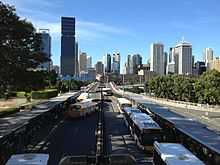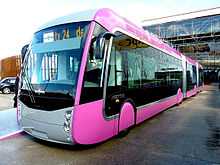Bus rapid transit
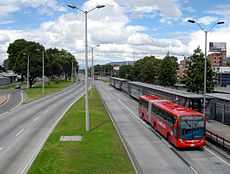
Bus rapid transit (BRT, BRTS, Busway) is a bus-based mass transit system. A true BRT system generally has specialized design, services and infrastructure to improve system quality and remove the typical causes of delay. Sometimes described as a "surface subway", BRT aims to combine the capacity and speed of light rail or metro with the flexibility, lower cost and simplicity of a bus system.[1]
To be considered BRT, buses should operate for a significant part of their journey within a fully dedicated right of way (busway) to avoid traffic congestion. In addition, a true BRT system has most of the following elements:
- Alignment in the center of the road (to avoid typical curb-side delays)
- Stations with off-board fare collection (to reduce boarding and alighting delay related to paying the driver)
- Station platforms level with the bus floor (to reduce boarding and alighting delay caused by steps)
- Bus priority at intersections (to avoid intersection signal delay)
The first BRT system was the Rede Integrada de Transporte ('Integrated Transportation Network') in Curitiba, Brazil, which entered service in 1974. This inspired many similar systems around Brazil and the world, such as TransMilenio in Bogotá, Colombia, which opened in 2000. As of October 2014, 186 cities in all continents have implemented BRT systems, accounting for 4,757 km (2,956 mi) of BRT lanes.[2] It is estimated that about 31.7 million passengers use BRT worldwide everyday, of which about 19.7 million passengers ride daily in Latin America, which has the most cities with BRT systems, with 60, led by Brazil with 33 cities.[2]
The many differences and distinct features among existing BRT systems made the Institute for Transportation and Development Policy form a BRT Standard Technical Committee in 2011, and, in 2013. It set a minimum definition of what features must be part of a system to qualify as BRT and created a BRT Standard to rate existing systems.[3]
Etymology

"Bus Rapid Transit" takes its name from rail rapid transit, which describes a high-capacity urban public-transit system with its own right of way, multiple-car vehicles at short headways, and longer stop spacing than traditional streetcars and buses. BRT uses buses on a wide variety of rights-of-way, including mixed traffic, dedicated lanes on surface streets, and busways separated from traffic.
The expression 'BRT' is mainly used in the Western Hemisphere and China; in India, it is called 'BRTS' (BRT System); in Europe and Australia, it is often called a busway, while elsewhere, it may be called a quality bus.
History
The first BRT system in the world was the Rede Integrada de Transporte (RIT, "Integrated Transportation Network"), implemented in Curitiba, Brazil, in 1974.[4][5] Most of the elements that have become associated with BRT were innovations first suggested by Curitiba Mayor Jaime Lerner.[6][7] Initially just dedicated bus lanes in the center of major arterial roads, in 1980 the Curitiba system added a feeder bus network and inter-zone connections, and in 1992 introduced off-board fare collection, enclosed stations, and platform-level boarding. Other systems made further innovations, including platooning (three buses entering and leaving bus stops and traffic signals at once) in Porto Alegre, and passing lanes and express service in São Paulo.[8]
In 1995, Quito, Ecuador, opened trolleybus BRT. The TransMilenio in Bogotá, Colombia, opening in 2000, was the first BRT system to combine the best elements of Curitiba's BRT with other BRT advances, and achieved the highest capacity and highest speed BRT system in the world. The success of TransMilenio spurred other cities to develop high quality BRT systems.
The first BRT in Asia, TransJakarta, opened in Jakarta, Indonesia, in January 2004. At 172 km is the longest BRT system in the world. Johannesburg’s BRT, Rea Vaya, was the first true BRT in Africa, in August 2009, carrying 42,000 daily passengers. Rea Vaya and Mio (BRT in Cali, Colombia, opened 2009) were the first two systems to combine full BRT with some services that also operated in mixed traffic, then joined the BRT trunk infrastructure.
Roughly four decades after the first BRT system was deployed, 186 cities in all continents have implemented BRT systems as of October 2014, accounting for 4,757 km (2,956 mi) of BRT lanes. It is estimated that about 31.7 million passengers use BRT worldwide everyday, of which, about 19.7 million passengers ride BRT daily in Latin America (62.4%), 8.5 million in Asia (26.9%) and 1.8 million in Europe (5.7%). Latin America is also the region with the most cities with BRT systems, with 60, of which, led by Brazil with 33 cities. Europe ranks second with 53, Asia with 38, and the United States and Canada with 26.[2]
Main features
BRT systems normally include most of the following features:
Dedicated lanes
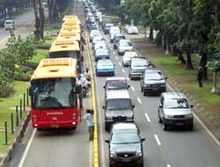
Bus-only lanes make for faster travel and ensure that buses are not delayed by mixed traffic congestion. Separate rights of way may be elevated, depressed, or in a tunnel, possibly using former rail routes. Transit malls or 'bus streets' may also be created in city centers.
Busway alignment
Center of roadway or bus-only corridor keeps buses away from the busy curb-side, where cars and trucks are parking, standing and turning.
Off-board fare collection
Fare payment at the station, instead of on board the bus, eliminates the delay caused by passengers paying on board.
Intersection treatment
Prohibiting turns for traffic across the bus lane significantly reduces delays to the buses. Bus priority will often be provided at signalized intersections to reduce delays by extending the green phase or reducing the red phase in the required direction compared to the normal sequence. Prohibiting turns may be the most important measure for moving buses through intersections.
Platform-level boarding
Station platforms are level with the bus floor for quick and easy boarding, making it fully accessible for wheelchairs, disabled passengers and baby strollers, with minimal delays.
High-level platforms for high-floored buses makes it difficult to have stops outside dedicated platforms, and to have normal buses stop at high-level platforms, so BRT stops have to be fully separated from other bus stops. In contrast to rail vehicles there is also a high risk of a dangerous gap between bus and platform.
An increasing popular variant is low-floor buses without steps at the door, which can allow easy boarding and have stops compatible with other buses.
Additional amenities

High-frequency all-day service
High capacity vehicles
High-capacity vehicles such bi-articulated buses may be used, typically with multiple doors to speed entry and exit. Double-decker buses or Guided buses may also be used. Advanced powertrain control may be used for a smoother ride.
Quality stations

BRT systems typically feature significant investment in enclosed stations which may incorporate attractive sliding glass doors, staffed ticket booths, information booths, and other more standard features listed above. They will often include level boarding, using either low-floor buses or higher boarding platforms level, and multiple doors to speed passenger boardings and enhance accessibility to disabled passengers. Validation of ticket upon entry to the 'station' rather than boarding the bus in a similar manner to that used on entry to a subway system is also common, particularly at busy stations.
Prominent brand or identity
(e.g. Viva, Max, TransMilenio, Metropolitano, Select) marking stops and stations as well as the buses.[9] A unique and distinctive identity contributes to its attractiveness as an alternative to driving cars.[10]
Large cities usually have big bus networks. A map showing all bus lines might be incomprehensible and cause people to wait for low frequency buses. By branding a number of main bus lines having high frequency, with a special brand and separate maps, it is easier to understand the main network.
Performance
A BRT system can be measured by a number of factors. The BRT Standard was developed by the Institute for Transportation and Development Policy (ITDP) to score BRT corridors, producing a list of rated BRT corridors meeting the minimum definition of BRT. The highest rated systems received a "gold" ranking. The latest edition of the standard was published in 2014.[11] The following table lists the seven systems that were rated Gold based on the 2013 standard.[12]
| City | BRT System (Corridor Name) |
|---|---|
| | GBRT (Zhongshan Avenue) |
| | Transmilenio (Americas, Calle 80, Calle 26, Norte-Quito-Sur, SUBA, and El Dorado) |
| | Curitiba BRT (Linha Verde) |
| | BRT (TransOeste) |
| | El Metropolitano |
| | Macrobús |
| | Metroplús |
Other metrics used to evaluate BRT performance include:
- The vehicle headway is the average time interval between vehicles on the same line. Buses can operate at headways of 10 seconds or less, but average headways on TransMilenio at busy intersections are 13 seconds,[13] 14 seconds for the busiest section of the Metrobus (Istanbul).
- Vehicle capacity, which can range from 50 for a conventional bus up to some 200 for an articulated vehicle arranged for standing passengers. Merobus Istanbul operates both Mercedes Citaro with a capacity of 150 and Mercedes CapaCity with a capacity of 193.
- The effectiveness of the stations to handle passenger demand. High volumes of passengers on vehicles required large bus stations at busy interchange points.
- The effectiveness of the feeder system - can these deliver people to stations at the required speed.
- Local passenger demand. Without a local demand for travel, the capacity will not be used.
Based on this data, the minimum headway and maximum current vehicle capacities, the theoretical maximum throughput measured in passengers per hour per direction (PPHPD) for a single traffic lane is some 90,000 passengers per hour (250 passengers per vehicle, one vehicles every 10 seconds). In real world conditions TransMilenio holds the record, with 35,000 - 40,000 PPHPD with most other busy systems operating in the 15,000 to 25,000 range.
| Location | System | Peak passengers per hour per direction | Passengers per day | Length (km) |
|---|---|---|---|---|
| Bogotá | TransMilenio | 35,000 - 40,000[14] | 2,154,961[15] | 106[16] |
| Guangzhou | Guangzhou Bus Rapid Transit | 26,900[17] | 1,000,000 | 22 |
| Curitiba, Brazil | Rede Integrada de Transporte | 13,900 – 24,100 | 508,000[18] (2,260,000 inc. feeder lines[19]) | 81 |
| Mexico City, Mexico | Mexico City Metrobus | 18,500 | 850,000 | 115 |
| Belo Horizonte, São Paulo | 15,800 - 20,300[20] | 24 | ||
| Istanbul | Metrobus (Istanbul) | 7,300 – 19,500[20] | 800,000 | 52 |
| Lahore | Metrobus (Lahore) | 10,000[21] | 180,000[22] | 28 |
| Tehran[23] | Tehran Bus Rapid Transit | 2,000,000[24] | 150 | |
| Jakarta | TransJakarta | 350,000 | 208 | |
| New Jersey | Lincoln Tunnel XBL | 15,500[25] | 62,000 (4 hour morning peak only) | |
| Brisbane | South-East Busway | 15,000[26] | 23 |
Comparison with light rail (LRT) and metro systems
After the first BRT system opened in 1974, cities were slow to adopt BRT because they believed that the capacity of BRT was limited to about 12,000 PPHPD. While this is a capacity rarely needed in the US (12,000 is more typical as a total daily ridership), in the developing world this capacity constraint was a significant argument in favor of heavy rail metro investments in some venues.
When TransMilenio opened in 2000, it changed the paradigm by giving buses a passing lane at each station stop and introducing express services within the BRT infrastructure. These innovations increased the maximum achieved capacity of a BRT system to 35,000 passengers per hour. Light rail, by comparison, has reported passenger capacities between 3,500pph (mainly street running) to 19,000pph (fully Grade-separated). "From these findings ... there is little evidence to support the view that LRT can carry more than busways.".[27] There are conditions that favor LRT over BRT, but they are fairly narrow. To meet these conditions you would need a corridor with only one available lane in each direction, more than 16,000 passengers per direction per hour but less than 20,000, and a long block length, because the train cannot block intersections. These conditions are rare, but in that specific instance, light rail would have a significant operational advantage.
Comparison with conventional bus services
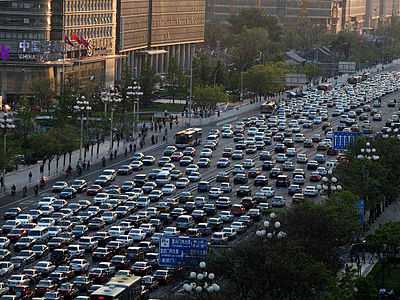
Conventional scheduled bus services use general traffic lanes, which can be slow due to traffic congestion, and the speed of bus services is further reduced by the time spent at bus stops for passengers to board the vehicle, pay the fare, and to pull back into traffic.
In 2013, the New York City authorities noted that buses on 34th Street, which carried 33,000 bus riders a day on local and express routes, traveled at 4.5 miles per hour (7.2 km/h), only slightly faster than walking pace. Even despite the implementation of Select Bus Service (New York City's bus rapid transit system), dedicated bus lanes, and traffic cameras on the 34th Street corridor, buses on the corridor were still found to travel at an average of 4.5 mph.[28]
In the 1960s, Reuben Smeed predicted that the average speed of traffic in central London would be 9 miles per hour (14 km/h) without other disincentives such as road pricing, based on the theory that this was the minimum speed that people will tolerate. When the London congestion charge was introduced in 2003, the average traffic speed was indeed 14 kilometres per hour (8.7 mph) which was the highest speed since the 1970s.[29] By way of contrast, typical speeds of BRT systems range from 17 to 30 miles per hour (27 to 48 km/h).[30]
Cost
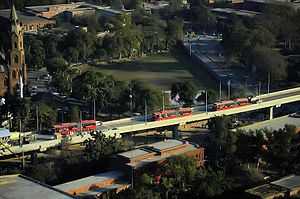
The capital costs of implementing BRT are lower than for LRT. A study by the United States Government Accountability Office from 2000 found that the average capital cost per mile for busways was $13.5 million while light rail average costs were $34.8 million.[31] However, the total investment varies considerably due to factors such as cost of the roadway, amount of grade separation, station structures, traffic signal systems and vehicles.
Operational costs of running a BRT system are generally lower than light rail, though the exact comparison varies. In the study done by the GAO, BRT systems usually had lower costs based on "operating cost per vehicle hour", "operating cost per revenue mile", and "operating cost per passenger trip", mainly because of lower vehicle cost and lower infrastructure cost. Diesel BRT is also much less expensive than a trolleybus system.[32]
In the developing world the operating cost advantages of BRT over LRT or streetcar are greater. For the same level of ridership, higher labor costs in the US relative to in developing countries will tend to encourage US transit operators to use fewer larger vehicles and operate them at lower frequencies in order to minimize the number of drivers needed. This comes at a hidden cost to passengers who experience lower frequency and longer waiting times.
Proponents of light rail argue that the operating costs of BRT are not necessarily lower than light rail. The typically larger light rail vehicles enjoy reduced labor costs per passenger, and the unit capital cost per passenger can be lower than BRT.[33]
An ambitious LRT system runs partly underground, which gives free right-of-way and much faster traffic compared to passing the traffic signals needed in a surface level system. Underground BRT is rare and expensive and gives air quality problems. An alternative is an elevated busway, which is also costly. Desire for grade separation indicates that a rail alternative could be better.
Examples
TransMilenio was described as a "model BRT system" in the National Bus Rapid Transit Institute's May 2006 report. It serves Bogotá with high-capacity articulated buses, which passengers can board through three doors. Bi-articulated buses are used on the busiest routes. A smart card system is used for off-board fare collection. Despite moving 45,000 ppdph, Transmilenio faces huge problems (especially during peak hours), in terms of not being quite organized, nor having the necessary capacity for handling the high passenger volume, a situation not being limited to peak hours but at most times along the day.[13]
Ottawa's transitway and the Martin Luther King Jr. East Busway (in Pittsburgh) offer limited stop services along dedicated 'freeway High-occupancy vehicle lanes.
Metrobus (Lahore)-Punjab-Pakistan, currently operates a fleet of 64 buses.[34] The buses run on a single 28.7 km long corridor which includes Ferozepur Road, Model Town, Badshahi Mosque, Mozang Chungi, Gaddafi Stadium and other commercial parts of city. with two other corridors being under construction. Buses on the current route have an average speed of 26 km/h.[35] According to the Lahore Transport Company, the daily ridership of the Metrobus exceeds 180, 000 with the peak hourly ridership being 10,000 passengers per hour per direction (p/h/d).
Good example of high quality stations include those on TransMilenio, the MIO in Cali, Metrolinea in Bucaramanga and Megabús in Pereira) and most other Latin American BRT systems. This design is also used in Johannesburg's Rea Vaya.[36] The term "station" is more flexibly applied in North America and ranges from enclosed waiting areas (Ottawa and Cleveland), and large open-sided shelters (Los Angeles).

BRTS in Ahmedabad in Gujarat, India, also known as Janmarg BRTS (People's way), has earned several awards and is regarded as the most efficient and the best in India. It complements the existing bus service of AMTS. It has considerably improved urban public transport. There are almost 100 BRTS stations with over 10 lines adding up to around 70 km. All BRTS stations except two are wheelchair accessible. Those in older areas of the city known as Walled City are constructed on the 'heritage' theme.
BRTS in Rajkot in Gujarat, India is known as Rajpath, meaning royal way to travel. It is improved bus system with high-class service at low cost, fully functional since October 2012. It is planned and executed by Vijay Anadkat Special City Engineer and head of JnNURM at Rajkot Municipal corporation.
Environmental issues
The typical bus diesel engine causes noticeable levels of air pollution, noise and vibration. With hybrid vehicles and trolleybuses, BRT designers hope to increase ride quality and decrease pollution. Since the energy used for acceleration is proportional to the vehicle mass, electric traction allows lighter vehicles, faster acceleration, and the ability to feed energy back into batteries or the power grid through regenerative brakes.
BRT can use trolleybuses to lower gaseous and noise emissions. The price penalty of installing overhead lines could be offset by the environmental benefits, potential for savings from centrally generated electricity, especially in cities where electricity is less expensive than other power sources. Trolleybus applications can be converted to light rail with the only extra expense being the laying and maintenance of tram tracks in the street.
In tunnels or tunnel systems

A special issue arises in the use of buses in metro transit structures. Since the areas where the demand for an exclusive bus right-of-way are apt to be in dense downtown areas where an above-ground structure may be unacceptable on historic, logistic, or environmental grounds, use of BRT in tunnels may not be avoidable.
Since buses are usually powered by internal combustion engines, bus metros raise ventilation issues similar to those of motor vehicle tunnels. Powerful fans typically exchange air through ventilation shafts to the surface; these are usually as remote as possible from occupied areas, to minimize the effects of noise and concentrated pollution.
A straightforward way to reduce air quality problems is to use internal combustion engines with lower emissions. The 2008 Euro V European emission standards set a limit on carbon monoxide from heavy-duty diesel engines of 1.5 g/kWh, one third of the 1992 Euro I standard. As a result, less forced ventilation will be required in tunnels to achieve the same air quality.
A different alternative is to use electrical propulsion. Seattle in its Metro Bus Tunnel, and Boston in Phase II of its Silver Line are using this method in their BRTs. In Seattle, dual-mode (electric/diesel electric) buses manufactured by Breda were used until 2004, with the center axle driven by electric motors obtaining power from trolley wires through trolley poles in the subway, and with the rear axle driven by a conventional diesel powertrain on freeways and streets. Boston is using a similar approach, after initially using trolleybuses pending delivery of the dual-mode vehicles in 2005. In 2004, Seattle replaced its "Transit Tunnel" fleet with diesel-electric hybrid buses, which operate similarly to hybrid cars outside the tunnel and in a low-noise, low-emissions "hush mode" (in which the diesel engine operates but does not exceed idle speed) when underground.[38][39]
The need to provide electric power in underground environments brings the capital and maintenance costs of such routes closer to those of light rail, and raises the question of building or eventually converting to light rail. In Seattle, the downtown transit tunnel was retrofitted for conversion to a shared hybrid-bus and light-rail facility in preparation for Seattle's Central Link Light Rail line, which opened in July 2009.
See also
- Bus rapid transit creep
- Express bus service
- Guided busway
- List of bus rapid transit systems
- Quality Bus Corridor
- Queue jump
- Straddling bus
- Sustainable transportation
- Traffic engineering (transportation)
- Transit bus
- Trolley bus
References
- ↑ "What is Bus Rapid Transit?". Select Bus Service website. NY Metropolitan Transit Authority. Retrieved 12 March 2010.
- ↑ 2.0 2.1 2.2 EMBARQ - The WRI Center for Sustainable Transport. "Global BRT Data - Worldwide and Key indicators per region". BRTdata.org. Retrieved 2014-10-21.
- ↑ Greenfield, John (2013-03-12). "Taking the Guesswork Out of Rating BRT: An Interview With Walter Hook | Streetsblog Chicago". Chi.streetsblog.org. Retrieved 2014-02-24.
- ↑ "Recapturing Global Leadership in Bus Rapid Transit - A Survey of Select U.S. Cities" (PDF). Institute for Transportation and Development Policy. May 2011. Retrieved 7 June 2011. pp. 5
- ↑ Cervero, Robert (1998), The Transit Metropolis, Island Press, Washington, D.C., pp. 265–296, ISBN 1-55963-591-6 Chapter 10/Creating a Linear City with a Surface Metro: Curitiba Brazil
- ↑ "Bus Rapid Transit". EMBARQ. Retrieved 2014-02-24.
- ↑ "Architect of possible dreams". Congresosibrt.org. 2013-05-08. Retrieved 2014-02-24.
- ↑ Latin American Experience With Bus Rapid Transit Gerhard Menckhoff, World Bank. August 2005. Retrieved 08-15-13.
- ↑ What is Select Bus Service? NYC Metropolitan Transit Authority. Retrieved 12 March 2010
- ↑ Characteristics of BRT for decision making. page ES-8. Federal Transit Administration (August 2004).
- ↑ Institute for Transportation and Development Policy (ITDP) (2014). "About the Standard: What's New in 2014?". ITDP. Retrieved 2014-06-22.
- ↑ "2013 Corridor Rankings". Institute for Transportation and Development Policy. Retrieved 2014-06-22.
- ↑ 13.0 13.1 "Applicability of Bogotá's TransMilenio BRT System to the United States" NBRTI (May 2006). Retrieved 15 March 2010.
- ↑ "Foro TransMilenio Fase III" (PDF).
- ↑ "Transmilenio 2013 statistics" (PDF). transmilenio.gov.co. Retrieved 2014-03-08.
- ↑ length (km)
- ↑ "International Public Transport Conference 2010 - Case Study of the Guangzhou BRT". Retrieved 5 August 2010.
- ↑ "BRT Data Latin America / Brazil / Curitiba". Retrieved 2014-08-24.
- ↑ "Intermodal Connectivity to BRT: A Comparative Analysis of Bogotá and Curitiba" (PDF). Journal of Public Transportation. Retrieved 2014-03-24.
- ↑ 20.0 20.1 "Characteristics of BRT for decision making" (PDF). Federal Transit Administration. 1 August 2004.
Exhibit 3-22: "Maximum observed peak hour bus flows, capacities, and passenger flows at peak load points on transitways"
- ↑ Metrobus (Lahore)#Operation
- ↑ https://www.facebook.com/pages/Development-in-Lahore/395736037168546
- ↑ Tehran Bus Rapid Transit
- ↑ http://www.heraldboy.com/tehran-bus-rapid-transit-transports-2-million-passengers-daily/623/
- ↑ American Public Transit Association (APTA). "Public Transportation: Moving America Forward" (PDF). APTA.
accessdate=2012-04-26
See p. 6, based on 62,000 people in the 4 hour morning rushhour - ↑ "Lord Mayor's Mass Transit Taskforce Report 2007". Brisbane City Council.
- ↑ G. Gardner, J. C. Rutter and F. Kuhn (1994). The performance and potential of light rail transit in developing cities. Project Report No. PR69. Transport Research Laboratory, Crowthorne, UK.
- ↑ "34th Street Select Bus Service".
Bus service along 34th Street is among the slowest in the city. Buses travel at an average of 4.5 mile per hour, only slightly faster than walking. Despite these slow speeds, 34th Street is a major east-west bus corridor, carrying over 33,000 bus riders a day on local and express routes.
- ↑ "Impacts monitoring - fifty annual report" (PDF). Transport for London.
- ↑ "Characteristics of BRT for decision making." (PDF). Federal Transit Administration. 1 August 2004. p. ES-5.
- ↑ GAO (September 2001). "Bus Rapid Transit Shows Promise" (PDF). GAO. Retrieved 16 March 2011.
- ↑ GAO (September 2001). "Bus Rapid Transit Shows Promise" (PDF). GAO. Retrieved 29 April 2012.
- ↑ Bus Rapid Transit or Quality Bus Reality Check Light Rail Now! (22 January 2004). Retrieved 29 March 2010
- ↑ Khan, Rameez. "Public transport: Govt to order studies on new Metro Bus projects". The Express Tribune. Retrieved 6 August 2013.
- ↑ "Lahore BRT System Study" (PDF). Lahore Transport Company. Retrieved 7 August 2013.
- ↑ Rea Vaya
- ↑ "Van Hool presents the ExquiCity Design Mettis.". Retrieved 5 June 2012.
- ↑ Metro Online (14 December 2007). "Downtown Seattle Transit Tunnel and Changing Bus Technology". King County Metro. Retrieved 13 July 2010.
- ↑ Duncan Allen (2005). "MBTA Silver Line". www.nycsubway.org. Retrieved 13 July 2010.
Further reading
| Wikimedia Commons has media related to Bus rapid transit. |
- General information
- The BRT Standard 2014 Edition Institute for Transportation and Development Policy
- Bus Rapid Transit Planning Guide (2007) A very comprehensive 800 guide to creating a successful BRT system by the Institute for Transportation and Development Policy (available in English, Spanish and Portuguese)
- Bus Rapid Transit, Volume 1: Case Studies in Bus Rapid Transit Transportation Research Board
- Bus Rapid Transit, Volume 2: Implementation Guidelines Transportation Research Board
- "Characteristics of Bus Rapid Transit". National Bus Rapid Transit Association. 2009.
- Levinson, Herbert S. (2002). "Bus Rapid Transit: An Overview" (PDF). Journal of Public Transportation 5 (2).
- Across Latitudes and Cultures Bus Rapid Transit An international Centre of Excellence for BRT development
- Transit Capacity and Quality of Service Manual Transportation Research Board
- BRT Technologies: Assisting Drivers Operating Buses on Road Shoulders. University of Minnesota Center for Transportation Studies, Department of Mechanical Engineering
- Country specific information
- Recapturing Global Leadership in Bus Rapid Transit - A Survey of Select U.S. Cities (available for download in pdf) Institute for Transportation & Development Policy (May 2011)
- Wang Fengwu and James Wang (April 2004). "BRT in China" (PDF). Public Transport International. Retrieved 10 March 2010.
- Vincent, William; Lisa Callaghan Jerram (April 2008). "Bus Rapid Transit and Transit Oriented Development: Case Studies on Transit Oriented Development Around Bus Rapid Transit Systems in North America and Australia" (PDF). Washington, DC: Breakthrough Technologies Institute.
- Bus Rapid Transit Shows Promise U.S. General Accounting Office
- The National BRT Institute (USA)
- Databases
- Global BRT Data Database of Bus Rapid Transit systems around the world
| ||||||||||||||||||
| ||||||||||||||||||||||||||||||||||||||||||||||
| ||||||||||||||||||||||||||
